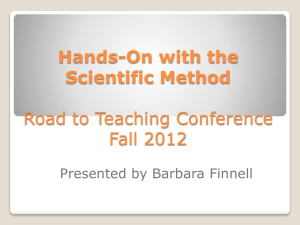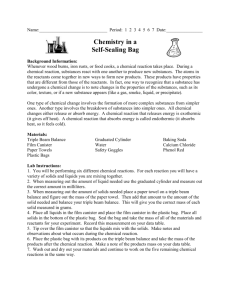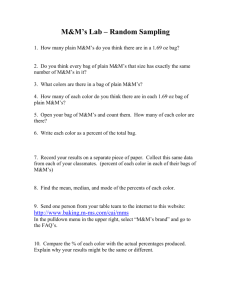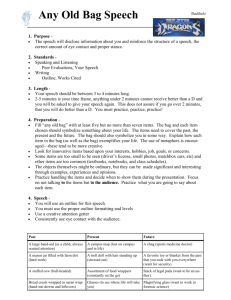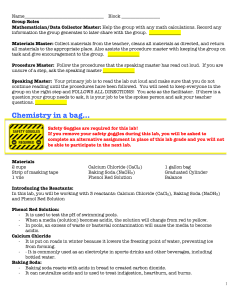Barbara Finnell - Scientific Method 2012
advertisement
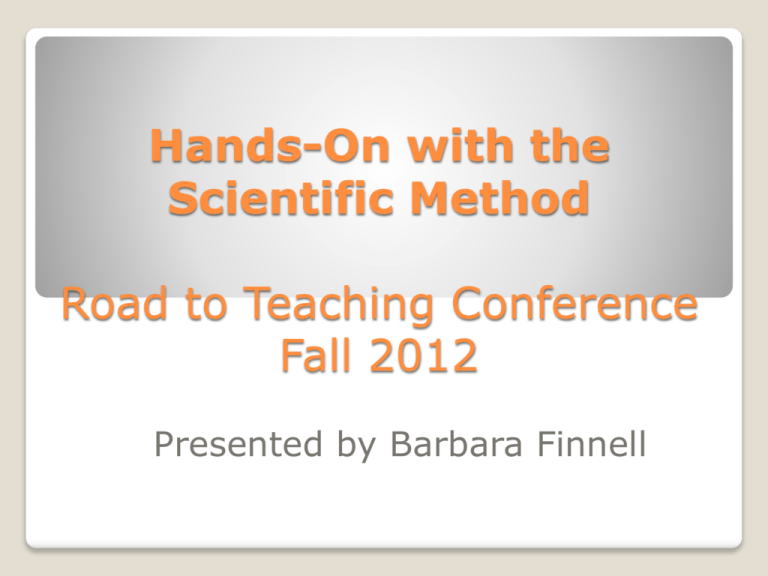
Hands-On with the Scientific Method Road to Teaching Conference Fall 2012 Presented by Barbara Finnell On your pre-assessment paper please list what you remember of the six steps of the scientific method. Put it to the side. Let’s practice it. Move to groups of four when possible. Get books, 2 per group Scientific Method What do you remember about the Scientific Method? ◦ Usually dry and calculated ◦ Rehearsing a lab with a lot of repetition and no new findings ◦ Do this because it’s what you do, not because you are inspired This experience turns that experience upside down Let’s go over a few ground rules though What is your experience? Follow instructions Be clam and careful Don’t taste things Smell substances like a chemist Protect your eyes Tell your teacher if you have allergies Report all spills, accidents and injuries to your teacher Wash you hands after class Never mix chemicals without permission Safety with science Look through the Chemical Reactions Everywhere book with a partner. What type of reactions did you find? Get materials Observe the materials, remember how we smell chemicals. Chemical Reactions Person #1, place 2 scoops of Calcium Chloride in a zip bag and label the bag with “2 scoops CaCl” Person #2, place 1 scoop of Baking soda into the same bag. Add “1 scoop Baking Soda” to bag. Get out most of the air Person #3 measure 10 ml of Phenol Red and write it on the bag. Don’t add it Person #4 when I say “mix” put the Phenol red in the bag and zip it closed. Experiment One Step One-Ask a question ◦ Together as a group discuss what happened. ◦ What questions do you have about what happened and how. ◦ Write them down on your sheet. ◦ Are there any questions you have about the HYG reaction that you can TEST? For instance, today we can guess what phenol red is but can test what it is. ◦ What question will you settle on? ◦ How will you test it? Scientific Method Step Two: Do Background Research ◦ In this case we are going to pull from our own background as our research. ◦ Do we know anything about these chemicals? ◦ Share what you know ◦ Does any group want to change their question or how they will test it? Scientific Method Step Three: Construct a hypothesis ◦ Make a prediction on your paper about what you will do and what you think will happen. ◦ Create a recipe that you will test to see if it will make the change you are hoping for. ◦ 2 scoops CaCl ◦ No Baking soda ◦ 10 ml phenol red ◦ We think it will turn red and not have gas present Scientific Method Step Four: Test your hypothesis by experiment ◦ Conduct your experiment and record your data ◦ So take your supplies and go ahead with your experiment. ◦ Try letting different people use different chemicals from last time. Scientific Method Step Five: Analyze data and draw conclusions ◦ What do you think about what you found? ◦ What evidence do you have? ◦ What did each group find? Scientific Method Step six: Communicate Results ◦ Share with others what you found. ◦ Share your conclusions ◦ What would you be interested in trying as next steps. ◦ Were you correct? Scientific Method With faculty With my children Serious scientists Yup. . . We really kept experimenting And oh yes, with the boy scouts Trying it out with standard appropriate 4th/5th graders Do you have another alteration to your question? Try it one more time. What would you try next time? Try it again Take out your pre-assessment card Put away your notes Write down the steps of the Scientific method on the card Roots of Reading/Seeds of Science by Delta www.scienceandliteracy.org
